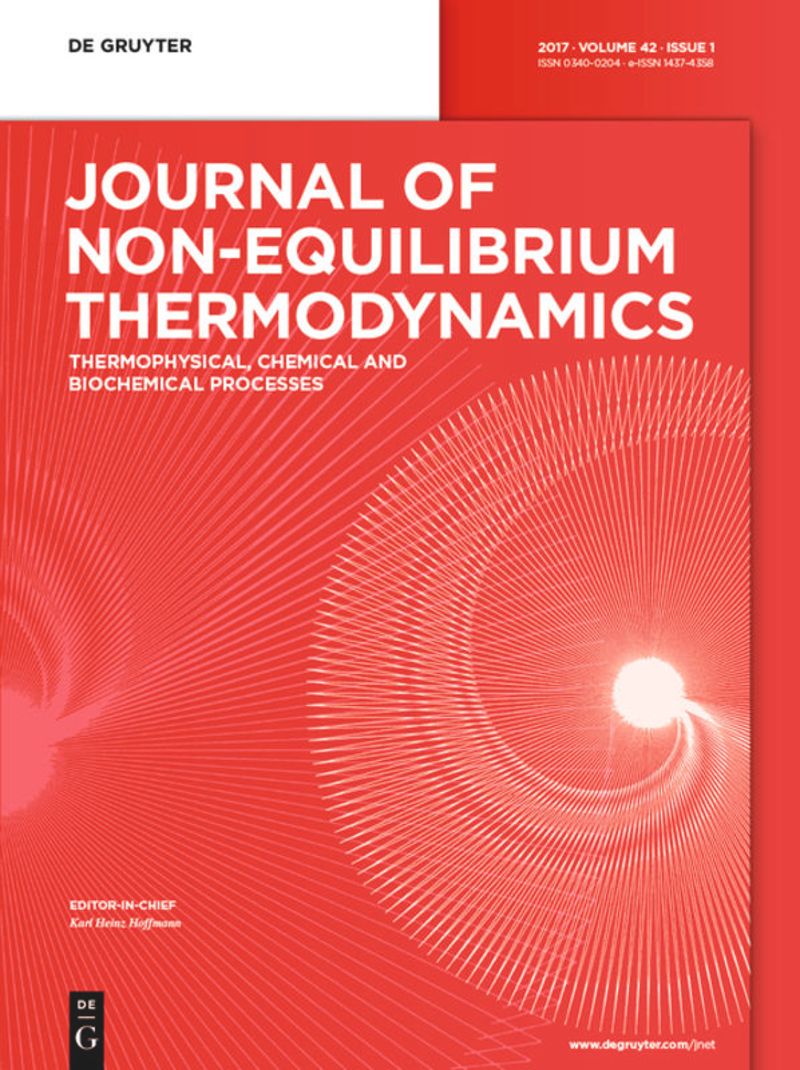通过求解麦克斯韦-玻尔兹曼 PDEs 系统建立非均质带电气流的新型不可逆模型:多组分等离子体的不可逆分析
IF 4.2
3区 工程技术
Q1 MECHANICS
引用次数: 0
摘要
作为我们之前文章[J. Non-equilibrium. Thermodyne. 49 (2024), 1-21]的延伸和进一步发展,提出了非均质带电气体流动的新模型和新的不可逆分析。我们研究了稀释非均质带电气体问题的非稳态瑞利流精确解的非平衡不可逆热力学(NIT)特性。与以往的研究不同的是,在诱导电磁力的影响下,带电气体是非均质的,平板移动阻尼随时间变化,并且考虑了正离子的影响,从而在理解自然等离子体动力学方面取得了重大进展。我们正在求解八个非均质偏微分方程(PDE)。我们使用了拉普拉斯变换技术和小参数方法。据我们所知,作为两项新的科学成就,我们为带电气体混合物引入了一个新的数学模型,用于计算热动力、动力学系数和通量变量(见附录)。其次,我们提出了一项神奇的新技术,即利用速度分布函数(VDF),通过流程图逐步确定多组分等离子体的平衡时间。我们指出,电子作为速度较快的轻组分,比速度较慢的重组分更快达到平衡。我们使用了一个标准实验室氩等离子体模型来应用这些结果。本文章由计算机程序翻译,如有差异,请以英文原文为准。
Novel irreversibility modeling of non-homogeneous charged gas flow by solving Maxwell–Boltzmann PDEs system: irreversibility analysis for multi-component plasma
A novel modeling and new irreversibility analysis of non-homogeneous charged gas flow is presented as an extension and further development of our previous article [J. Non-equilibrium. Thermodyne. 49 (2024), 1–21]. We study the non-equilibrium irreversible thermodynamics (NIT) properties of the exact solution to the dilute non-homogeneously charged gas problem with unsteady Rayleigh flow. In contrast to previous research, the charged gas is non-homogeneous under the influence of induced electromagnetic forces, the flat plate moving damping with time, and the effect of positive ions is considered, leading to significant advancements in understanding natural plasma dynamics. We are solving eight non-homogeneous partial differential equations (PDE). We used a Laplace transformation technique and small parameters methods. To the best of our knowledge, as two new scientific achievements, we introduced a new mathematical model for a mixture of charged gas to calculate the thermodynamic forces, kinetic coefficients, and fluxes variables, see Appendices. Second, we present a fantastic new technique by a flowchart to identify the equilibrium time of multi-component plasma step-by-step using the velocity distribution function (VDF). We indicate that electrons, which are faster lighter components, reach equilibrium faster than slower heavier components. A standard laboratory argon plasma model is used to apply the results.
求助全文
通过发布文献求助,成功后即可免费获取论文全文。
去求助
来源期刊
CiteScore
9.10
自引率
18.20%
发文量
31
审稿时长
1 months
期刊介绍:
The Journal of Non-Equilibrium Thermodynamics serves as an international publication organ for new ideas, insights and results on non-equilibrium phenomena in science, engineering and related natural systems. The central aim of the journal is to provide a bridge between science and engineering and to promote scientific exchange on a) newly observed non-equilibrium phenomena, b) analytic or numeric modeling for their interpretation, c) vanguard methods to describe non-equilibrium phenomena.
Contributions should – among others – present novel approaches to analyzing, modeling and optimizing processes of engineering relevance such as transport processes of mass, momentum and energy, separation of fluid phases, reproduction of living cells, or energy conversion. The journal is particularly interested in contributions which add to the basic understanding of non-equilibrium phenomena in science and engineering, with systems of interest ranging from the macro- to the nano-level.
The Journal of Non-Equilibrium Thermodynamics has recently expanded its scope to place new emphasis on theoretical and experimental investigations of non-equilibrium phenomena in thermophysical, chemical, biochemical and abstract model systems of engineering relevance. We are therefore pleased to invite submissions which present newly observed non-equilibrium phenomena, analytic or fuzzy models for their interpretation, or new methods for their description.

 求助内容:
求助内容: 应助结果提醒方式:
应助结果提醒方式:


